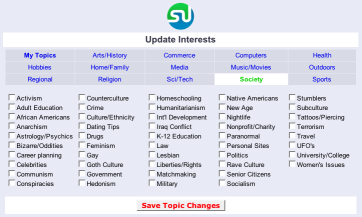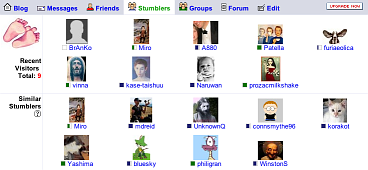Stumble your way around the web
Of course the web has never had an index and everyone knows that the only way to find interesting stuff on the ‘net is to search at a search engine.
But in practice there have always been other options. In the early days of the web, sites offering a “random link” were pretty common - a click on the link would land you anywhere on the known web, which was a pretty good way of finding interesting sites. But as both the web and its inhabitants mulitiplied so did the range of subjects hosted online and the untargetted random link lost its attraction - the chances of landing somewhere interesting to you was limited.
And email has always facilitated personal recommendation. Who hasn’t found good sites on the recommendation of a friend? And haven’t we all stumbled upon a site and thought “I know someone who would love this”? And as it turns out, stumbling provides a whole old/new way to find stuff on the web.
Everythin’ old is new again
StumbleUpon (www.stumbleupon.com) is an online service that revives and renews the old random link idea by merging it with personal recommendations. As a member (or “stumbler”) you are able to receive recommendations and make your own suggestions for interesting web pages using buttons on an add-in toolbar for Internet Explorer and the Mozilla-based browsers (e.g. Firefox and Netscape).
When you sign-up to StumbleUpon, you choose your areas of interest from about five hundred available topics. Then whenever you want to stumble onto a new page clicking the “Stumble!” button causes a random page to be chosen from one of those areas and loaded into your browser. But it isn’t just any old random page - to be available in StumbleUpon a page must have been recommended by another stumbler with similar interests, therefore increasing the chance that you will find it interesting also.
Fig 1 - A sample of the topics available in StumbleUpon

As a stumbler, you may also rate the sites that are presented: either “I like it!” (thumbs-up) or “Not for me” (thumbs-down). Not only does this help stumbles for other visitors, it also helps to fine-tune your own future stumbles. And stumblers are encouraged to add new links all the time by hitting the “I like it!” button as they browse, this keeps the link collection relevant and current.
It’s a community
StumbleUpon provides a number of tools to help build a community feeling among stumblers. Firstly, as a stumbler you get a profile page at stumbleupon.com where you can publish some information about yourself and upload a photo. Stumblers usually allow their latest thumbs-up choices to be displayed on their profile page.
Every link stored at StumbleUpon has a reviews page where stumblers can add comments (positive or negative) about that particular web page. Any page reviews that you make are also shown blog-style on your profile page. Other stumblers who visit your profile page can also leave comments or send you a private message.
Then there are the concepts of “friends” and “fans”. If you find another stumbler who always make good recommendations, you can nominate that person as a “friend” and their thumbs-up choices will be directed to you. When you nominate someone as a friend, you become one of their “fans”.
StumbleUpon also provides online chat, discussion groups and forums for stumblers, but the key tool provided by StumbleUpon is the toolbar.
A quick tour of the toolbar
First there is the “Stumble!” button, which you use to make a stumble. Next is the topic menu. If this is set to “All”, then stumbles will be selected from any of your topic areas or you can limit your stumbles to a specific topic area. There is also an option to change your topic selections.
Fig 2 - The StumbleUpon toolbar

In the next section of the toolbar are the two ratings buttons: “I like it!” and “Not for me”. This is how you vote on web pages.
In the third section is the page reviews button, the home button, and the toolbar menu. Going to a review of a page lets you see who intially suggested that page, who else has given it the thumbs-up, and any comments other stumblers have made about the page. There’s also other information such as the topic area to which the page is allocated, the language of the page, the date when the page was suggested, and how much stumbling has happened. In additions to making comments, stumblers can suggest that the page be allocated to a different topic or different language.
The home button takes you to your profile page - we’ll get to that shortly.
The stumbler menu offers a grab-bag of functions including the ability to view a history of all your stumbles, change your topic selection, and change toolbar options. A handy option is “Stumble after rating” - if you choose “Not for me”, whenever you rate a page thumbs-down the system will automatically stumble you onto a new page.
On privacy - an update
I previously reported that StumbleUpon was logged you page use. The guys from StumbleUpon have talked to me about this and I am satisfied that this doesn’t happen. The feature which led me to believe that this happened is no longer part of the toolbar interface.
However like any online system, it’s a good idea to log off StumbleUpon when you’re not actively using it. Select “Sign Out” from the menu and you’re out.
Stumbling home
Your profile page offers several views:
“Blog” is where your recent positive ratings and comments are posted - this is roughly what other stumblers see of your profile
“Messages” holds any messages sent to you from other stumblers
“Friends” lists anyone you have nominated as a friend
“Stumblers” shows people who have viewed your profile recently and other stumblers who have similar interests, all with links to their profiles:
Fig 3 - The profile page in “Stumblers” view

“Groups” provides some suggested discussion groups that reflect your interests
“Forum” is an aggregation of several discussion groups about StumbleUpon
“Edit” is where you put in your personal details
While the blog facilities are good, if you are a committed blogger you might prefer more sophisticated tools. However StumbleUpon does provide your comments and recent ratings as RSS feeds so you incorporate the data elsewhere.
A few quibbles
I’ll admit that StumbleUpon has become my favourite web tool (and it’s easily the second biggest time-waster I have at the moment) so it’s a bit of a shame that the toolbar is not available for all browsers - Opera and Safari simply miss out. I see no reason why the StumbleUpon features couldn’t be available through a normal web interface so that addicts like me could still have access to the “Stumble!” button while I’m away from my own computer - it’s simply not possible to install the toolbar everywhere. But this is a minor quibble.
There has also been some recent concern among some stumblers that the StumbleUpon servers are not coping with the growing population of stumblers. Some grumblings in the forums suggest that the service is sometimes slow and unresponsive, although I have not noticed this to any great extent.
The great stumble forward
The experience of stumbling is different to searching. The results from a search are closely focussed around the search terms, but search engines make no value judgments - there are no human ratings of the results. While a stumble is less focussed, the results are all of good quality because all pages have had a prior recommendation from at least one other stumbler.
StumbleUpon is a clever idea, well implemented and a welcome revival of the random link concept. The topic groupings and ratings system ensure that most stumbles provide relevant and interesting results. StumbleUpon is an easy way to make serendipitous discoveries happen.
tech.thingoid Gosbell First published: PC Update Oct 2004